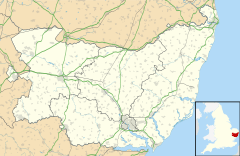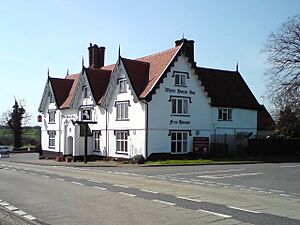Stoke Ash facts for kids
Quick facts for kids Stoke Ash |
|
|---|---|
 All Saints Church, Stoke Ash |
|
| Population | 314 (2011) |
| District | |
| Shire county | |
| Region | |
| Country | England |
| Sovereign state | United Kingdom |
| Post town | Eye |
| Postcode district | IP23 |
| Police | Suffolk |
| Fire | Suffolk |
| Ambulance | East of England |
| EU Parliament | East of England |
Stoke Ash is a small village in eastern England. It is located in the Mid Suffolk area of Suffolk county. About six miles south of Diss, the village had 314 people living there in 2011. Stoke Ash shares a local government group, called a parish council, with the nearby village of Thwaite.
The village sits on the A140 road. This road connects the cities of Norwich and Ipswich.
The name "Stoke" comes from an old English word. It means a place or a smaller settlement. "Ash" comes from an old Anglian word for an ash tree. The name "Ash" was added to "Stoke" in the 1500s.
In 1086, Stoke Ash was written down as "Stoches Stotas" in the Domesday Book. This was a big survey of England ordered by William the Conqueror.
Contents
Early History of Stoke Ash
There is proof that people from ancient Rome lived in Stoke Ash. Many Roman coins and pieces of pottery have been found here. A small Roman site is also located on an old Roman road. This road went from Colchester to Caistor.
You can even see Roman tiles in the wall of the church tower. These are above the main door of All Saints Church. People have also found some Roman military items. These include pieces of household items from other countries.
Life in Stoke Ash Long Ago
In 1801, people in Stoke Ash were grouped by their jobs. These groups included farmers, traders, and craftspeople.
By 1831, most people worked as labourers or servants. About 56% of the population were in these jobs. Around 20% were considered middle class. Only 15% were employers or professionals. This shows how different jobs were back then.
Kelly's Directory of Suffolk from 1900 described the land. It said the soil was mixed with clay. The main crops grown were wheat, barley, and beans. The area covered about 1,200 acres.
The village also had a school. It was called the Parish School. It taught both boys and girls. About 50 students were signed up, and around 47 usually came to class.
A chart from 1831 shows the jobs of men over 20. The "middle sorts" included farmers who did not hire workers. It also included skilled workers in towns. This shows how jobs changed over time.
Stoke Ash Today
Today, Stoke Ash has several important places. These include All Saints Church, a village hall, and a village green. There is also a post office, a pub, and a place for boarding pets.
The A140 road goes right through the village. Most of the houses are east of the road. The church, village hall, and post office are also on this side. This makes it the main part of the village. A Baptist church and six more homes are to the north. The primary school and the White Horse Inn are on the west side of the A140.
The people living in Stoke Ash are generally older. They are older than the average person in the UK and in Suffolk. The 2011 UK Census showed that Stoke Ash has few immigrants. Fewer people were born in other EU countries or outside the EU. More people were born in the UK compared to the national average.
The census also showed that people in Stoke Ash feel healthier. More residents said their health was 'very good'. Fewer said their health was 'very bad'. This means people in Stoke Ash are usually happy with their health.
More people in Stoke Ash own their homes. They either own them completely or have a mortgage. This is higher than the national average. It suggests that Stoke Ash is a fairly wealthy area.
The chart shows the types of jobs people had in 2011. Jobs were spread out fairly evenly across different areas. This is a big change from 1831. Back then, most people worked as servants.
All Saints Church
All Saints Church can be seen across a field. It is to the east of the A140 road. The church tower was built in the 1300s. It has decorated openings for the bells. There is also a later window on the west side. A large stair tower rises on the south side.
The north wall has flint pebbles laid in rows. The round arches of the old doors show that the church was first built during the Norman period. These doors are now blocked up.
The main window has three lights and decorated patterns. The east window was replaced in the 1800s. There are tall, thin windows on the south side. Diamond crosses made of Flushwork are on two church supports. They might be consecration crosses, but they are placed unusually high.
The brick porch was built in the late 1400s. It has a small space above the outer arch. There is also a small stoop by the inner door. The windows were put in during a big repair in 1868. This was done by Richard Phipson.
The inner doorway is very plain. It is only about 6 feet tall and 3 feet 6 inches wide. Phipson also removed the plaster from the ceilings. This showed the wooden roof structure. The benches were designed by Phipson. The seats in the chancel have beautiful medieval poppyheads.
The tower arch is tall and narrow. At its bottom is part of an old bell. This bell was made between 1460 and 1480. It was cast by the oldest known bell maker in Bury St Edmunds. The bell has a Latin message: "Credo in Deum Patrem Omni Potentem." This means "I believe in God, the Father Almighty."
Above the south door are old royal arms. They are from the time of the Hanoverian kings. They were repainted for William IV in 1836. They are painted on wooden boards. There is no longer a chancel arch or screen. But stairs to the rood loft are still there.
The pulpit is from the early 1600s. It has carved panels. The small priest’s door is inside a much larger arch. In the north wall, there is a large, plain space. It might have been an aumbry, a cupboard for church items.
The decalogue (Ten Commandments) is painted on a metal plate. It is on the east wall. Next to it is a piscina, which is a basin for washing sacred vessels. In the nearby window, there are small pieces of glass from the 1400s. These show a single hand and a book.
The church records go all the way back to the year 1550.
The White Horse Inn
The White Horse Inn is a place to stay. It offers bed and breakfast. It is located on the A140 road. It is near the town of Eye in Suffolk. The inn is about halfway between Ipswich and Norwich.
This inn is very old. It dates back to the 1600s. In those days, it was a coaching inn. This means it was a place where horse-drawn coaches would stop. It was built when Charles I of England was king.




